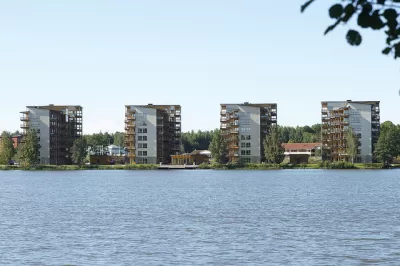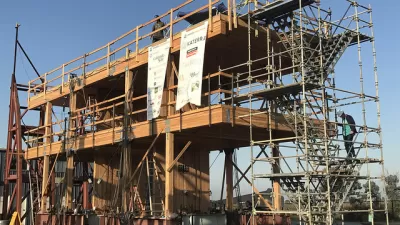Building with wood is back in fashion, but lumber producers have to reckon with thorny politics and new timber-based materials that have yet to be truly defined.

Matthew Messner reviews the history and politics of wood as a building material in a special timber issue of The Architect's Newspaper:
“Over the past 150 years, the process and politics of wood have shaped a highly efficient industry that still provides the vast majority of the U.S.’s house-building material. With new technology, wood is pushing into new territories, and the lumber industry is bracing to respond to these demands.”
Anyone following developments in the built environment has seen the re-rise of wood construction. Timber towers are going up in France, in England, and most recently, “an academic and professional collaboration” produced a timber-based design for the River Beech Tower in Chicago, in part because “it is lighter, more easily transportable and has a smaller environmental impact than its concrete or steel counterparts.”
“Although the lumber industry is confident it can handle an increase in demand,” Messner writes, “there are factors that will need to be addressed.” These include political maneuvering between the U.S. and Canada, updating fire codes, and establish legal definitions for new products like cross-laminated timber (“a true wonder material,” maybe).
FULL STORY: The lumber industry looks to respond to the rise of mass timber

Planetizen Federal Action Tracker
A weekly monitor of how Trump’s orders and actions are impacting planners and planning in America.

Congressman Proposes Bill to Rename DC Metro “Trump Train”
The Make Autorail Great Again Act would withhold federal funding to the system until the Washington Metropolitan Area Transit Authority (WMATA), rebrands as the Washington Metropolitan Authority for Greater Access (WMAGA).

DARTSpace Platform Streamlines Dallas TOD Application Process
The Dallas transit agency hopes a shorter permitting timeline will boost transit-oriented development around rail stations.

Renters Now Outnumber Homeowners in Over 200 US Suburbs
High housing costs in city centers and the new-found flexibility offered by remote work are pushing more renters to suburban areas.

The Tiny, Adorable $7,000 Car Turning Japan Onto EVs
The single seat Mibot charges from a regular plug as quickly as an iPad, and is about half the price of an average EV.

Supreme Court Ruling in Pipeline Case Guts Federal Environmental Law
The decision limits the scope of a federal law that mandates extensive environmental impact reviews of energy, infrastructure, and transportation projects.
Urban Design for Planners 1: Software Tools
This six-course series explores essential urban design concepts using open source software and equips planners with the tools they need to participate fully in the urban design process.
Planning for Universal Design
Learn the tools for implementing Universal Design in planning regulations.
Municipality of Princeton
Roanoke Valley-Alleghany Regional Commission
City of Mt Shasta
City of Camden Redevelopment Agency
City of Astoria
Transportation Research & Education Center (TREC) at Portland State University
US High Speed Rail Association
City of Camden Redevelopment Agency
Municipality of Princeton (NJ)





























